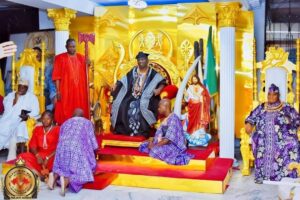
By The Merit Newspaper’s Correspondent
Oyo, Nigeria – Monday, September 15, 2025
OYO — A heated debate has broken out in Oyo town following the discovery of an image of Jesus Christ placed beside the royal throne at the Alaafin of Oyo’s palace. The development has stirred strong reactions, particularly among traditionalists who view the presence of the Christian symbol within the sacred Yoruba palace as inappropriate.
Reports indicate that the image, spotted by visitors near the king’s throne, quickly became a subject of public discussion both within and outside the palace. While some observers saw nothing wrong in the blend of cultural heritage and religious symbolism, others argued that it undermines the sanctity of the centuries-old traditional institution.
Leaders of traditional religion groups in Oyo have called for the immediate removal of the portrait. According to them, the Alaafin’s palace represents the spiritual and cultural identity of the Yoruba people and should remain neutral in matters of faith.
“The palace is not a church or mosque. It is the custodian of Yoruba culture and tradition. Placing an image of Jesus Christ beside the throne is a desecration of our heritage,” one traditionalist leader, who requested anonymity, told The Merit Newspaper’s correspondent.
However, reactions from Christian groups in the community paint a different picture. Many Christians argue that there is no harm in having a religious image in the palace, especially in a country where freedom of worship is constitutionally guaranteed.
READ ALSO:Back to School: Securing Nigeria’s Future Through Education
“Nigeria is a multi-religious society. If Muslims can pray in the palace, and traditionalists offer sacrifices, there is nothing wrong if an image of Jesus is placed there. It is a matter of tolerance and inclusion,” said Pastor Oriyomi Ezekiel, a cleric in Oyo town.
The controversy has also spilled onto social media, where residents and cultural enthusiasts across Nigeria are debating the appropriateness of mixing religion with royal tradition. While some see it as a reflection of Nigeria’s diversity, others fear it could set a precedent that may erode long-held customs.
Historical Significance of the Alaafin Stool
The Alaafin of Oyo is one of the most powerful and historically revered monarchs in Yorubaland, tracing his lineage to the ancient Oyo Empire, which dominated large parts of West Africa between the 14th and 19th centuries. The empire, with its capital at Old Oyo (also called Oyo-Ile), was renowned for its sophisticated political structure, military strength, and cultural influence across the region.
The Alaafin’s stool is not merely a political symbol but also a spiritual institution. The Alaafin is traditionally regarded as Iku Baba Yeye — “the one who embodies both life and death” — a custodian of Yoruba spirituality and ancestral heritage. His palace, considered sacred ground, has historically been a site for rituals, festivals, and decisions that shaped the cultural destiny of the Yoruba people.
Cultural historians note that any introduction of foreign religious imagery into such a space is bound to spark intense reactions. For many Yoruba traditionalists, the palace must remain a sanctuary of indigenous identity, free from overt symbols of Christianity or Islam, even though these religions have long coexisted with traditional beliefs in modern Nigeria.
Awaiting the Palace’s Response
The Alaafin’s palace has yet to issue an official statement on the matter. However, palace sources suggest that consultations may be ongoing to prevent the issue from escalating further.
Analysts say the outcome of this controversy could set a new precedent for how traditional institutions in Nigeria balance cultural heritage with the country’s religious plurality.
READ ALSO:Demo Cocktail Services Redefines Lagos Event Experience
As the debate continues, many await the palace’s final stance on whether the controversial image will remain beside the throne or be removed in deference to cultural sensitivities.
Editor’s Note / Clarification
Following publication, a concerned indigene of Oyo State, Mr. Abiodun Aluko, contacted The Merit Newspaper to clarify that the image in circulation was not taken at the Alaafin’s throne. Instead, the photograph was captured at the Igbinedion Palace in Benin City, Edo State, during the 91st birthday celebration of Chief Gabriel Igbinedion, the Esama of Benin.
According to Mr. Abiodun, Chief Igbinedion vacated his own seat in honour of the Alaafin — a gesture he was also known to extend to the late Alaafin.
















